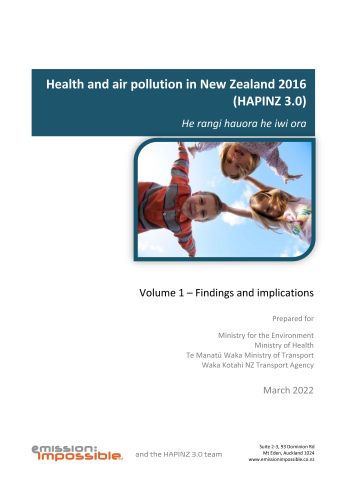This report summarises the updated health and air pollution in New Zealand 2016 (HAPINZ 3.0) study which evaluates the effects of air pollution on human health across New Zealand and the resulting social costs.
The authors of the study (Kuschel et al) estimated anthropogenic (human-made) air pollution in New Zealand was responsible for approximately 3,300 premature deaths per year and social costs of $15.6 billion per year.
The original HAPINZ study was undertaken by Fisher et al in 2007. It was updated in 2012 by Kuschel et al.
Data file
Please contact Environmental.Reporting@mfe.govt.nz for the Excel spreadsheet containing the exposure model and effects model data for the updated HAPINZ 3.0 study.
This report summarises the updated health and air pollution in New Zealand 2016 (HAPINZ 3.0) study which evaluates the effects of air pollution on human health across New Zealand and the resulting social costs.
The authors of the study (Kuschel et al) estimated anthropogenic (human-made) air pollution in New Zealand was responsible for approximately 3,300 premature deaths per year and social costs of $15.6 billion per year.
The original HAPINZ study was undertaken by Fisher et al in 2007. It was updated in 2012 by Kuschel et al.
Data file
Please contact Environmental.Reporting@mfe.govt.nz for the Excel spreadsheet containing the exposure model and effects model data for the updated HAPINZ 3.0 study.
Suite of publications
| Key findings infographic | A graphical overview of the key findings from the health and air pollution in New Zealand 2016 (HAPINZ 3.0) study. |
| Detailed methodology | Technical information for the health and air pollution in New Zealand 2016 (HAPINZ 3.0) study. |
| Health effects model – Users’ guide | A users’ guide to the health effects model underpinning the health and air pollution in New Zealand 2016 (HAPINZ 3.0) study. |
| How to talk about air quality and environmental health | Communication strategies for experts, communicators, and advocates with a focus on air quality. |
